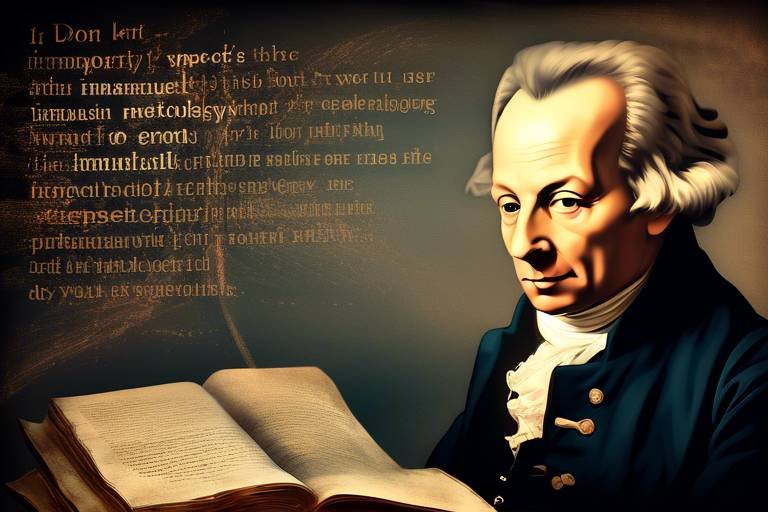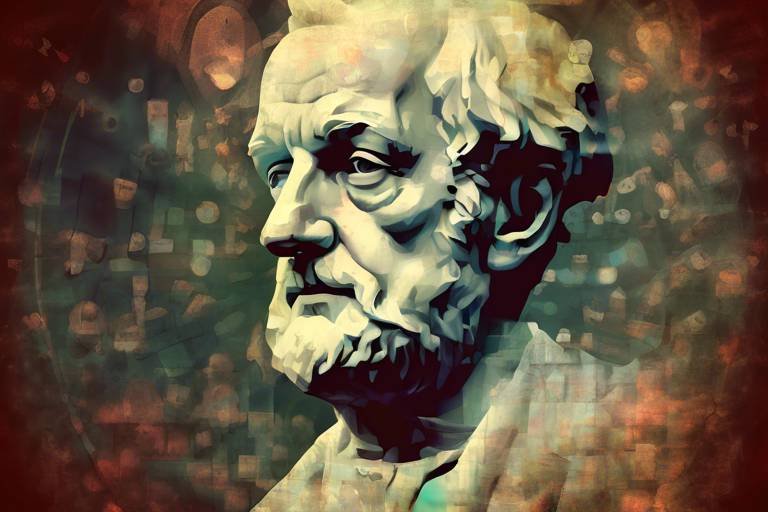Dummett’s Philosophy of Language and Thought - An Exploration
In the realm of philosophy, few thinkers have ventured as deeply into the intricate web of language and thought as Michael Dummett. His explorations challenge us to reconsider the fundamental ways we perceive meaning, communication, and even reality itself. Dummett’s philosophy is not just an academic exercise; it’s a profound inquiry into how language shapes our understanding of the world around us. By focusing on the nuances of language, he invites us to explore the very fabric of our thoughts and interactions.
Dummett's exploration of meaning emphasizes that it is not a static entity waiting to be discovered, but rather a dynamic construct shaped by our use of language. In his view, meaning is derived from how we use words in various contexts, rather than from the objects or ideas they reference. This perspective shifts the focus from a traditional view of meaning as a direct correlation between words and their referents to a more fluid understanding where context and usage play pivotal roles. In essence, language becomes a living tool that evolves with our experiences and interactions.
When we think about language, it's easy to see it merely as a vessel for expressing thoughts. However, Dummett argues that language is much more than that; it is a tool for communication that facilitates understanding between individuals. This means that the effectiveness of communication hinges not just on the words themselves, but on the shared contexts and intentions of the speakers. Dummett’s view prompts us to ask: How often do we misinterpret each other simply because we overlook the context in which words are spoken? By recognizing the intricate dance between language and communication, we can better appreciate the challenges and beauties of human interaction.
At the heart of Dummett's philosophy lies the idea of contextualism. He posits that the meaning of a statement is profoundly influenced by the context in which it is uttered. For instance, consider the phrase "It’s cold in here." Depending on whether it's said in a cozy living room or a chilly office, the implications can vary dramatically. This contextual understanding of language invites us to consider how our interpretations can shift based on situational factors, cultural backgrounds, and even the emotional states of the speakers. Such an approach not only enriches our understanding of language but also emphasizes the importance of empathy in communication.
Dummett's integration of pragmatics into semantic theory is another critical aspect of his philosophy. He argues that understanding meaning requires us to consider the speaker's intentions and the contextual factors at play. This means that when we communicate, we are not just exchanging words but also sharing intentions, emotions, and cultural nuances. For example, when someone says, "Can you pass the salt?" it's not merely a question about the salt; it's an implicit request. Dummett's emphasis on pragmatics encourages us to look beyond the literal meanings of words and to appreciate the layers of meaning that exist in our everyday conversations.
Dummett's perspective on truth challenges traditional notions that view truth as an absolute, unchanging entity. Instead, he suggests that truth is contingent upon our linguistic practices and the contexts in which we operate. This raises fascinating questions: Is truth universal, or is it shaped by our language and culture? Dummett's insights compel us to reconsider how we define truth and to recognize that our understanding of it may be as fluid as language itself. By situating truth within the realm of language, Dummett opens the door to a more nuanced and adaptable understanding of what it means to know something.
Dummett's anti-realism posits that our understanding of reality is mediated through language. This assertion has significant implications for contemporary philosophical debates. If our grasp of reality is shaped by the language we use, then how do we engage with concepts that lie outside our linguistic frameworks? Dummett's anti-realism encourages us to acknowledge the limitations of our language and to consider how these limitations affect our understanding of the world. This perspective not only challenges traditional realist views but also invites a deeper exploration of how language influences our perception of reality.
Dummett's work extends beyond language and thought into the realm of mathematics, where he challenges conventional views about mathematical truth and knowledge. His approach invites us to reconsider what it means to "know" something in mathematics and how this knowledge is constructed through language and practice. By doing so, he opens up a dialogue about the very foundations of mathematical understanding.
One of the key aspects of Dummett's philosophy is his constructivist approach to mathematics. He emphasizes the importance of proof and constructive methods in understanding mathematical truth. This perspective shifts the focus from a search for absolute truths to a recognition of the processes and methods through which mathematical knowledge is built. In this light, mathematics becomes a dynamic field, continually evolving as new proofs and methods are developed.
Dummett's philosophy has profound implications for how mathematics is practiced and understood. By advocating for a constructivist approach, he influences educational methodologies, encouraging students to engage with mathematics as a process of discovery rather than a collection of static truths. This shift in perspective not only enhances the learning experience but also fosters a deeper appreciation for the beauty and complexity of mathematics.
- What is Dummett's main contribution to philosophy? Dummett's main contributions include his insights on the nature of meaning, language, and the implications of anti-realism.
- How does Dummett's philosophy impact our understanding of truth? Dummett challenges the notion of absolute truth, suggesting that truth is contingent upon linguistic practices and contexts.
- What is constructivism in mathematics according to Dummett? Constructivism emphasizes the role of proof and constructive methods in understanding mathematical truth, shifting focus from static truths to dynamic processes.

The Nature of Meaning
Dummett's exploration of meaning is nothing short of revolutionary. He argues that meaning is not an intrinsic property of words but rather something that is shaped by use. Imagine language as a living organism; it evolves, adapts, and grows based on how we interact with it. This perspective shifts the focus from the traditional view where meaning is tied to reference—where words point to objects or concepts in the world—to a more dynamic understanding where meaning emerges from the context in which language is employed.
To illustrate this idea, consider the word "bank." Depending on the context, it could refer to a financial institution, the side of a river, or even a place to store something. The meaning of "bank" is not fixed; it is fluid and changes based on how we use it in conversation. Dummett emphasizes that we derive our understanding of meaning through practical engagement, suggesting that the act of using language is what ultimately gives it significance.
Furthermore, Dummett posits that language serves as a tool for communication, allowing individuals to convey thoughts, emotions, and intentions. This tool-like quality of language means that its effectiveness hinges on the shared understanding between speakers. When we communicate, we are not just exchanging words; we are engaging in a complex dance of interpretation where each participant must grasp the nuances of the other's context. This dynamic interaction is what makes language so powerful yet so challenging.
In Dummett's view, the nature of meaning can be summarized through a few key points:
- Meaning as Use: Meaning is derived from how language is used in various contexts.
- Contextual Dependence: The interpretation of language is heavily influenced by the surrounding context.
- Communication as Interaction: Language is a tool for facilitating understanding and interaction between individuals.
This understanding of meaning has profound implications for how we perceive thought and communication. If meaning is not a static reference but a dynamic process, then our thoughts are also fluid and shaped by the linguistic frameworks we employ. This leads to a more nuanced view of how we engage with the world around us, suggesting that our cognitive processes are deeply intertwined with the language we use.
In conclusion, Dummett's philosophy invites us to reconsider our assumptions about meaning. By emphasizing the role of use and context, he opens up new avenues for understanding not just language, but also the very fabric of communication and thought itself. As we continue to navigate the complexities of language, Dummett's insights remind us of the importance of context and interaction in shaping our understanding of the world.
- What does Dummett mean by "meaning as use"?
Dummett suggests that the meaning of a word is determined by how it is used in various contexts rather than by its reference to an object or idea. - How does context influence meaning?
The context in which language is used can change its interpretation, making meaning fluid rather than fixed. - Why is communication considered an interaction?
Communication involves not just the exchange of words, but also a shared understanding between speakers that shapes the meaning of their interactions.

Language and Communication
Language is more than just a collection of words and grammar rules; it's the very fabric of our social existence. Dummett emphasizes that language is not merely a tool for expressing thoughts, but rather a dynamic medium through which we convey meaning and facilitate understanding among individuals. Think about it for a moment: when we speak, we’re not just tossing around vocabulary; we are engaging in a complex dance of communication that relies on shared experiences, cultural contexts, and even emotional undertones.
In Dummett's view, the essence of communication lies in its interactive nature. When we communicate, we are not just transmitting information; we are inviting others into a conversation, creating a space for dialogue, and fostering connections. This idea challenges the traditional notion that communication is a straightforward transfer of information. Instead, it highlights the importance of context, intention, and the roles of both speaker and listener in shaping meaning.
Moreover, Dummett argues that language serves as a bridge between our internal thoughts and the external world. It allows us to articulate our thoughts, emotions, and perceptions, thereby enabling us to engage with others. This brings us to a fascinating aspect of Dummett's philosophy: the idea that the meaning of a statement is often derived from its use in a particular context. For instance, the phrase "It's cold in here" could express a simple observation, a complaint, or even a request to close a window, depending on the situation and the relationship between the speakers. This highlights how language is not static; it evolves and adapts to the nuances of human interaction.
To illustrate this further, let’s consider a simple table that outlines different contexts and how they can alter the meaning of a single phrase:
| Context | Phrase | Possible Meanings |
|---|---|---|
| Social Gathering | "Nice weather today!" | Small talk, expressing enjoyment |
| Job Interview | "Nice weather today!" | Breaking the ice, establishing rapport |
| Argument | "Nice weather today!" | Mocking, sarcasm |
This table exemplifies how the same phrase can carry different meanings based on context, emphasizing Dummett's point that language is inherently tied to the situations in which it is used. The implications of this understanding extend beyond mere semantics; they challenge us to rethink how we engage in dialogue and how we interpret the words of others.
Ultimately, Dummett’s exploration of language and communication invites us to embrace a more nuanced view of human interaction. It suggests that to truly understand one another, we must pay attention not only to the words spoken but also to the context, the intentions, and the shared experiences that shape our conversations. This understanding can transform the way we communicate in our daily lives, making us more empathetic listeners and more thoughtful speakers.
As we navigate through our conversations, let’s remember that every exchange is an opportunity to connect, to understand, and to grow. After all, language is not just about words; it’s about the relationships we build and the meanings we create together.
- What is Dummett's main argument about language? Dummett argues that language is not merely a tool for expressing thoughts but a dynamic medium through which we convey meaning and facilitate understanding.
- How does context influence meaning in communication? Context shapes the interpretation of language, as the same words can have different meanings depending on the situation and the relationship between speakers.
- Why is understanding intention important in communication? Understanding intention helps us grasp the underlying meaning behind words, allowing for more effective and empathetic communication.

Contextualism in Language
When we dive into the depths of contextualism in language, we begin to see how meaning is not a fixed entity but rather a fluid concept that dances with the circumstances surrounding its use. Imagine trying to understand a joke without knowing the background story—much of its humor relies on the context in which it is told. Similarly, Dummett argues that our grasp of meaning hinges on the context in which words are uttered, rather than merely their definitions or the objects they refer to. This perspective challenges the traditional view that meaning is static and suggests that understanding is a dynamic process shaped by our interactions and experiences.
Dummett's contextualism posits that language is inherently tied to the situations in which it is embedded. For instance, consider the word "bank." In one context, it might refer to a financial institution, while in another, it could mean the side of a river. The listener's ability to decipher which meaning is intended relies heavily on contextual clues. This is where Dummett's philosophy shines; he emphasizes that the interpretation of language is not just about words but about the entire tapestry of communication, including tone, body language, and situational factors.
Furthermore, Dummett's approach encourages us to consider how meaning can shift over time and across different cultures. Words can evolve, and their significance can change based on societal norms and values. For example, the term "gay" has undergone a transformation from meaning "happy" to its modern connotation related to sexual orientation. This evolution exemplifies how contextual factors play a crucial role in shaping our understanding of language.
In practical terms, this means that effective communication requires not just a grasp of vocabulary but an awareness of the surrounding context. Think about conversations you've had—how often have you had to clarify your meaning because the other person interpreted your words differently? Dummett's insights remind us that communication is a two-way street, where both speaker and listener must navigate the complexities of context to achieve mutual understanding.
In summary, Dummett's contextualism invites us to embrace the idea that language is a living entity, constantly influenced by the nuances of context. By recognizing this, we can enhance our communication skills and deepen our understanding of how language shapes our thoughts and interactions. As we continue to explore the implications of contextualism, it becomes clear that meaning is not just found in words but in the rich tapestry of our shared experiences and the contexts that bind us together.
- What is contextualism in language? Contextualism is the philosophical approach that suggests the meaning of words is shaped by the context in which they are used, rather than being fixed or absolute.
- How does Dummett's contextualism differ from traditional views of meaning? Traditional views often see meaning as static and tied to definitions, while Dummett's contextualism emphasizes the fluidity of meaning based on situational factors.
- Why is context important in communication? Context is vital because it helps clarify the intended meaning behind words, which can vary significantly depending on the situation, culture, and prior knowledge of the interlocutors.

Pragmatics and Semantic Theory
When diving into Dummett's philosophy, one cannot overlook the intricate dance between pragmatics and semantic theory. These two components are not merely side notes in the grand narrative of language; they are the very fabric that weaves our understanding of meaning. Dummett argues that to fully grasp the essence of language, we must consider not just the words themselves, but the context in which they are uttered. Imagine trying to decipher a joke without understanding the cultural background or the emotional tone—much of its meaning would slip through your fingers like sand.
In Dummett's view, semantics—the study of meaning—cannot be divorced from pragmatics, which focuses on how context influences interpretation. He posits that the meaning of a statement is not fixed and absolute; rather, it is fluid, shaped by the intentions of the speaker and the circumstances surrounding the communication. For instance, consider the phrase “Can you pass the salt?” In a literal sense, it’s a question about ability. However, in a dining context, it’s a polite request, revealing how context can transform meaning entirely.
To illustrate this relationship, let’s consider a simple table that contrasts pragmatics and semantics:
| Aspect | Semantics | Pragmatics |
|---|---|---|
| Definition | Study of meaning in isolation | Study of meaning in context |
| Focus | Words and their definitions | Speaker's intent and context |
| Example | "Dog" refers to a domesticated canine | Understanding "dog" as a term of endearment in a specific conversation |
This interplay between pragmatics and semantics leads to a richer understanding of language. Dummett emphasizes that the speaker's intentions are crucial in interpreting statements. If I say, “It’s cold in here,” I might just be making an observation, or I could be hinting that I’d like someone to close the window. This subtlety highlights the importance of context, as it can dramatically alter the perceived meaning of a statement.
Moreover, Dummett's integration of pragmatics into semantic theory challenges traditional views of meaning as static and unchanging. He invites us to consider how our everyday conversations are filled with nuances that reveal the dynamic nature of language. This perspective encourages us to be more aware of how we communicate and interpret messages, fostering a deeper connection to the nuances of human interaction.
In conclusion, Dummett's exploration of pragmatics and semantic theory is not just an academic exercise; it is a vital lens through which we can view our daily communications. By understanding the interplay of context and meaning, we can enhance our ability to convey thoughts clearly and effectively, bridging the gap between mere words and genuine understanding.
- What is the difference between semantics and pragmatics? Semantics deals with meaning in isolation, while pragmatics focuses on how context influences meaning.
- Why is context important in understanding language? Context shapes the interpretation of statements, revealing intentions and nuances that words alone cannot convey.
- How does Dummett's philosophy impact communication? It encourages a deeper awareness of how we use language, promoting clearer and more effective communication.

Implications for Truth
Dummett’s perspective on truth significantly reshapes our understanding of this fundamental concept. Traditionally, truth has been viewed as an absolute, a static property that statements possess if they correspond to reality. However, Dummett challenges this notion by suggesting that truth is not merely about correspondence but is deeply intertwined with our linguistic practices and the contexts in which we engage in communication. This shift invites us to reconsider how we evaluate the truth of statements, emphasizing the role of language as a dynamic tool rather than a mere mirror reflecting reality.
In Dummett's view, the implications of this approach are profound. He posits that the truth of a statement is contingent upon the criteria for its verification. This means that what we consider to be true can vary based on the linguistic frameworks and contexts we employ. For example, a statement that might hold true in one context could be deemed false in another, depending on the underlying assumptions and the specific circumstances surrounding the discourse. This perspective leads us to ask: How do we determine the truth of our statements? Is it enough to simply look at the facts, or must we also consider the linguistic and contextual nuances?
To illustrate this point, consider the following table that summarizes Dummett's view on truth in relation to traditional perspectives:
| Aspect | Traditional View | Dummett's View |
|---|---|---|
| Nature of Truth | Absolute and static | Contingent and dynamic |
| Role of Language | Reflective of reality | Shaping our understanding |
| Criteria for Verification | Objective facts | Linguistic frameworks and context |
This table highlights how Dummett’s anti-realist stance invites us to engage with truth in a more nuanced manner. It encourages us to be mindful of the linguistic choices we make and the contexts in which we operate, leading to a richer understanding of communication and meaning. This perspective not only affects philosophical debates but also has practical implications in fields such as law, science, and everyday discourse, where the criteria for truth can significantly impact outcomes and interpretations.
Ultimately, Dummett's exploration of truth challenges us to rethink our approach to knowledge and understanding. Instead of seeking an elusive, objective truth, we are invited to appreciate the complexities of our linguistic interactions and the contexts that shape our beliefs. This realization can lead to a more collaborative discourse where differing perspectives are valued, fostering a deeper comprehension of the multifaceted nature of truth.
- What is Dummett's main argument regarding truth?
Dummett argues that truth is contingent upon linguistic practices and contexts, rather than being an absolute property of statements. - How does Dummett's view differ from traditional notions of truth?
Traditional views often see truth as static and objective, while Dummett emphasizes its dynamic nature influenced by language and context. - What are the implications of Dummett's philosophy for everyday communication?
Dummett's philosophy encourages us to consider the linguistic choices we make and the contexts in which we communicate, leading to richer interactions.

Anti-Realism and Its Significance
Dummett's anti-realism presents a fascinating lens through which we can examine our understanding of reality. At its core, anti-realism posits that our grasp of the world is intrinsically linked to the language we use. This perspective flips the traditional realist viewpoint on its head, suggesting that rather than discovering an objective reality, we are, in fact, constructing our understanding through linguistic frameworks. Imagine trying to navigate a complex maze; the path you take is often determined by the map you have in hand. In this analogy, the map represents the language we use, guiding our thoughts and interpretations of the world around us.
One of the significant implications of Dummett's anti-realism is its challenge to the notion of truth as an absolute concept. Instead of viewing truth as something that exists independently of our perceptions, Dummett argues that truth is contingent upon the practices and contexts of our linguistic interactions. This perspective invites us to rethink how we approach discussions about truth in various fields, from science to ethics. For instance, in scientific discourse, what we consider "true" may shift based on prevailing theories and the language used to describe them. This dynamic nature of truth can be both liberating and perplexing, as it encourages continual dialogue and reassessment.
Furthermore, Dummett’s anti-realism has profound implications for contemporary philosophical debates, particularly in areas such as metaphysics and epistemology. It questions the very foundations of how we understand knowledge and existence. If our grasp of reality is mediated through language, then the implications for disciplines like mathematics, ethics, and even the natural sciences are significant. For example, in mathematics, one might ask: Is a mathematical truth only valid within the framework of the language and axioms we accept? This leads to a rich discussion about the nature of mathematical entities and whether they exist independently of our conceptualizations.
To illustrate the significance of anti-realism, consider the following points:
- Language as a Construct: Our understanding of reality is shaped by linguistic constructs, making communication essential in shaping perceptions.
- Truth as Contextual: Truth becomes a fluid concept, influenced by cultural and contextual factors rather than a fixed entity.
- Philosophical Implications: Anti-realism invites deeper inquiry into the nature of existence and knowledge, prompting a reevaluation of established philosophical doctrines.
In conclusion, Dummett's anti-realism is not just a theoretical stance but a transformative approach that challenges us to reconsider our assumptions about language, truth, and reality. By recognizing the interplay between language and our understanding of the world, we can foster a more nuanced perspective that embraces complexity and invites ongoing exploration. The significance of this philosophy extends beyond academic discourse, influencing how we communicate, interpret, and engage with one another in our everyday lives.
- What is Dummett's anti-realism? Dummett's anti-realism suggests that our understanding of reality is shaped by language, challenging the notion of objective truth.
- How does anti-realism affect our understanding of truth? It posits that truth is not absolute but contingent on linguistic practices and contexts.
- What are the implications of anti-realism in mathematics? It raises questions about the nature of mathematical truths and whether they exist independently of our language and frameworks.
- Why is language important in Dummett's philosophy? Language is the medium through which we construct our understanding of reality, making it central to Dummett's views on thought and communication.

Philosophy of Mathematics
Dummett's contributions to the challenge the conventional views that have long dominated this field. At the heart of his philosophy lies a radical rethinking of what it means to understand mathematical truth and knowledge. Traditionally, mathematics has been seen as a realm of absolute truths, where concepts and theorems exist independently of human thought and language. Dummett, however, invites us to reconsider this perspective, suggesting that mathematical truths are not discovered but rather created through our linguistic practices and cognitive frameworks.
One of the most compelling aspects of Dummett's philosophy is his constructivist approach. He argues that mathematical objects do not exist in some abstract realm but are instead constructed through proofs and methods. This view aligns with the idea that mathematics is a human endeavor, deeply intertwined with the language we use to describe it. In this sense, Dummett's work emphasizes the importance of understanding how mathematical knowledge is generated and validated through constructive processes.
To illustrate Dummett's perspective, consider the following example: when a mathematician proves a theorem, they are not merely uncovering a pre-existing truth; they are actively engaging in a process that shapes our understanding of mathematical reality. This leads to a fascinating implication: if mathematical truths are contingent upon our methods of proof, then the nature of mathematics itself becomes a dynamic field, constantly evolving as new proofs and concepts emerge.
Moreover, Dummett's philosophy has significant implications for mathematical practice. It challenges educators and practitioners to rethink how mathematics is taught and understood. Instead of viewing mathematics as a collection of fixed truths to be memorized, Dummett's approach encourages a more exploratory and interactive learning environment where students engage with mathematical concepts through constructive methods. This shift not only enhances understanding but also fosters a deeper appreciation for the creative aspects of mathematics.
In summary, Dummett's philosophy of mathematics offers a refreshing perspective that encourages us to view mathematical truths as products of human activity rather than static entities. His constructivist approach reshapes our understanding of mathematical knowledge, emphasizing the role of language and proof in the creation of mathematical meaning. As we delve deeper into the implications of his work, we find ourselves questioning the very foundations of how we engage with mathematics and the nature of truth itself.
- What is Dummett's constructivist approach in mathematics?
Dummett's constructivist approach emphasizes that mathematical truths are created through proofs and methods rather than existing independently. This view highlights the role of human activity in shaping mathematical knowledge. - How does Dummett's philosophy influence mathematics education?
His philosophy encourages a more exploratory and interactive learning environment, where students engage deeply with mathematical concepts through constructive methods rather than rote memorization. - What are the implications of Dummett's philosophy for understanding mathematical truth?
Dummett suggests that mathematical truths are not absolute but contingent upon linguistic practices and the methods used to prove them, leading to a dynamic understanding of mathematics.

Constructivism in Mathematics
When we dive into the world of mathematics, we often think of it as a realm of absolute truths, where numbers and theorems exist in a perfect universe. However, Dummett's constructivism challenges this notion by suggesting that mathematical truths are not merely discovered but are instead created through our understanding and practices. In this view, mathematics is more than just a collection of abstract entities; it is a dynamic process shaped by human activity, where proof and constructive methods play a central role.
So, what does this mean for how we approach mathematics? Dummett argues that to truly grasp mathematical truths, we must engage in a process of construction. This means that a mathematical object does not exist independently of our ability to construct it. For example, when we think about the concept of a number, it isn't enough to simply say that the number "2" exists; we must understand how to identify it, represent it, and utilize it in various contexts. In essence, the existence of mathematical entities is contingent upon our capacity to construct them through proof and logical reasoning.
To further illustrate this point, consider the following table that contrasts traditional views of mathematical truth with Dummett's constructivist perspective:
| Aspect | Traditional View | Dummett's Constructivism |
|---|---|---|
| Existence of Mathematical Objects | Independent of human thought | Dependent on human construction |
| Truth of Mathematical Statements | Absolute and eternal | Contextual and contingent |
| Role of Proof | Verification of existence | Construction of understanding |
This shift in perspective has significant implications for how we teach and learn mathematics. Dummett's approach encourages educators to focus on the processes of reasoning and proof, rather than merely presenting students with established truths. By engaging students in constructive activities, they not only learn mathematical concepts but also develop critical thinking skills that are essential in a broader context.
Moreover, Dummett's constructivism aligns well with contemporary educational practices that emphasize problem-solving and inquiry-based learning. It invites students to explore mathematical ideas actively, fostering a deeper understanding of the subject. As students engage with mathematics through construction, they begin to appreciate the beauty and creativity involved in mathematical thinking.
In summary, Dummett's constructivist view of mathematics reshapes how we perceive mathematical truth and knowledge. It emphasizes that mathematics is not just about finding answers but about the journey of constructing those answers through proof and reasoning. This philosophy not only enriches our understanding of mathematics but also transforms how we approach teaching and learning in this vital field.
- What is Dummett's constructivism? Dummett's constructivism posits that mathematical truths are created through human activity and understanding rather than being discovered as absolute entities.
- How does this perspective affect mathematics education? It encourages a focus on reasoning and proof, promoting active engagement with mathematical concepts rather than passive absorption of established truths.
- Why is proof important in Dummett's view? Proof is essential as it serves as a means of construction, allowing individuals to understand and validate mathematical concepts through logical reasoning.
- Can Dummett's ideas be applied outside of mathematics? Yes, the principles of constructivism can be applied to various fields, emphasizing the role of human activity in shaping knowledge and understanding.

Implications for Mathematical Practice
Dummett's philosophy fundamentally reshapes our understanding of mathematical practice, challenging long-held beliefs about what constitutes mathematical truth and knowledge. His emphasis on constructivism, which posits that mathematical entities are not discovered but rather constructed through proofs and processes, has profound implications for how mathematics is taught and practiced today. This perspective encourages a shift away from viewing mathematics as a static body of knowledge, instead framing it as a dynamic field where understanding is built through active engagement and exploration.
One of the most significant implications of Dummett's ideas is the call for a more interactive approach to mathematics education. Instead of merely memorizing formulas and theorems, students are encouraged to delve into the reasoning behind mathematical concepts. This method not only fosters a deeper understanding but also promotes critical thinking skills that are essential in solving complex problems. For instance, when students are tasked with constructing their own proofs, they are not just learning mathematical facts; they are engaging with the very fabric of mathematical reasoning.
Moreover, Dummett's constructivist approach highlights the importance of proof in mathematics. In traditional views, a mathematical statement is often accepted as true if it can be shown to correspond to an external reality. However, Dummett argues that the validity of mathematical statements should be based on their provability within a given system. This leads to a more rigorous examination of mathematical practices, where the focus shifts from seeking absolute truths to understanding the processes that lead to mathematical conclusions.
To illustrate this shift, consider the following table that contrasts traditional views of mathematical truth with Dummett's constructivist perspective:
| Aspect | Traditional View | Dummett's Constructivism |
|---|---|---|
| Nature of Mathematical Truth | Absolute and discovered | Contextual and constructed |
| Role of Proof | Verification of truth | Construction of understanding |
| Learning Approach | Memorization of facts | Active engagement and exploration |
This shift in perspective not only affects how students learn but also influences the broader mathematical community. Mathematicians are encouraged to adopt more collaborative and exploratory practices, working together to build new knowledge rather than simply confirming existing theories. This collaborative spirit is essential in addressing contemporary mathematical challenges, as it fosters an environment where diverse ideas and approaches can flourish.
Ultimately, the implications of Dummett's philosophy extend beyond the classroom. They challenge educators and mathematicians alike to rethink their methodologies and embrace a more holistic view of mathematics as an evolving discipline. By focusing on the processes of construction and understanding, we can cultivate a mathematical culture that values inquiry, creativity, and collaboration—qualities that are vital in a world where mathematical literacy is increasingly important.
- What is Dummett's philosophy of mathematics? Dummett's philosophy emphasizes constructivism, suggesting that mathematical truths are constructed through proofs rather than discovered as absolute entities.
- How does Dummett's view affect mathematics education? It encourages a more interactive and exploratory approach, focusing on understanding and reasoning rather than rote memorization.
- What is the significance of proof in Dummett's philosophy? Proof is seen as a means of constructing understanding, rather than merely verifying truth.
- How can Dummett's ideas influence mathematical practice? They promote collaboration and exploration, encouraging mathematicians to work together to build new knowledge.
Frequently Asked Questions
- What is Dummett's philosophy of language?
Dummett's philosophy of language emphasizes that meaning is derived from the use of language rather than from a strict reference to objects or ideas. He argues that how we use language shapes our understanding of the world around us.
- How does Dummett view the relationship between language and communication?
According to Dummett, language is a vital tool for communication that enables individuals to convey thoughts and facilitate understanding. He believes that effective communication relies heavily on the context in which language is used.
- What is contextualism in language according to Dummett?
Dummett's contextualism posits that the meaning of language is influenced by its context. This means that understanding a statement or phrase requires considering the circumstances and intentions surrounding its use, rather than viewing it in isolation.
- How does Dummett integrate pragmatics into semantic theory?
Dummett's integration of pragmatics into semantic theory highlights that the interpretation of meaning is not just about the words used but also about the speaker's intentions and the contextual factors that affect communication.
- What are Dummett's views on truth?
Dummett challenges traditional notions of truth by suggesting that it is not an absolute concept. Instead, he argues that truth is contingent upon linguistic practices and the various contexts in which statements are made.
- What is anti-realism in Dummett's philosophy?
Anti-realism, as proposed by Dummett, suggests that our understanding of reality is mediated through language. This stance has significant implications for contemporary philosophical debates regarding the nature of truth and knowledge.
- How does Dummett contribute to the philosophy of mathematics?
Dummett challenges conventional views about mathematical truth and knowledge, promoting a constructivist approach that emphasizes the importance of proof and constructive methods in understanding mathematical concepts.
- What implications does Dummett's philosophy have for mathematical practice?
Dummett's philosophical insights have profound implications for how mathematics is practiced and understood, influencing educational approaches and the nature of mathematical inquiry in contemporary settings.



















